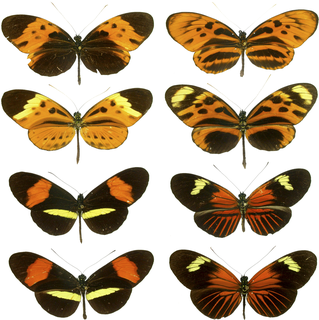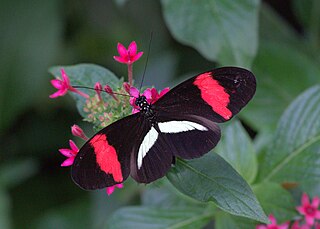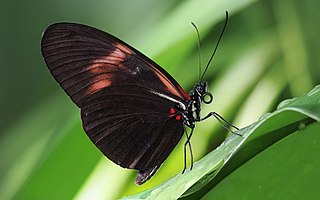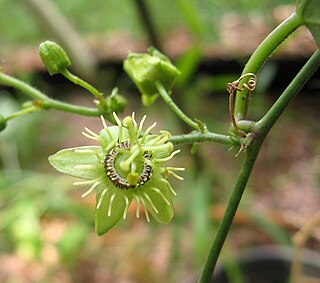
Passiflora, known also as the passion flowers or passion vines, is a genus of about 550 species of flowering plants, the type genus of the family Passifloraceae.

The Heliconiinae, commonly called heliconians or longwings, are a subfamily of the brush-footed butterflies. They can be divided into 45–50 genera and were sometimes treated as a separate family Heliconiidae within the Papilionoidea. The colouration is predominantly reddish and black, and though of varying wing shape, the forewings are always elongated tipwards, hence the common name.

Heliconius erato, or the red postman, is one of about 40 neotropical species of butterfly belonging to the genus Heliconius. It is also commonly known as the small postman, the red passion flower butterfly, or the crimson-patched longwing. It was described by Carl Linnaeus in his 1758 10th edition of Systema Naturae.

The Bayer Insectarium is an insectarium located within the St. Louis Zoo, in St. Louis, Missouri, United States. David Mason & Associates designed the $4 million, 9,000 square feet (840 m2) facility which opened in 2000. It houses educational exhibits and an active breeding and research facility. The research facility includes a window to the exhibits area and two-way communications so visitors may watch entomologists work and ask them questions. The facility also includes a geodesic flight dome cage, home to numerous rainforest flowers and butterfly species.

Heliconius cydno, the cydno longwing, is a nymphalid butterfly that ranges from Mexico to northern South America. It is typically found in the forest understory and deposits its eggs on a variety of plants of the genus Passiflora. It is a member of the Heliconiinae subfamily of Central and South America, and it is the only heliconiine that can be considered oligophagous. H. cydno is also characterized by hybridization and Müllerian mimicry. Wing coloration plays a key role in mate choice and has further implications in regards to sympatric speciation. Macrolide scent gland extracts and wing-clicking behavior further characterize this species.

Heliconius comprises a colorful and widespread genus of brush-footed butterflies commonly known as the longwings or heliconians. This genus is distributed throughout the tropical and subtropical regions of the New World, from South America as far north as the southern United States. The larvae of these butterflies eat passion flower vines (Passifloraceae). Adults exhibit bright wing color patterns which signal their distastefulness to potential predators.

Heliconius melpomene, the postman butterfly, common postman or simply postman, is a brightly colored butterfly found throughout Central and South America. It was first described by Carl Linnaeus in his 1758 10th edition of Systema Naturae. Its coloration coevolved with a sister species H. erato as a warning to predators of its inedibility; this is an example of Müllerian mimicry. H. melpomene was one of the first butterfly species observed to forage for pollen, a behavior that is common in other groups but rare in butterflies. Because of the recent rapid evolutionary radiation of the genus Heliconius and overlapping of its habitat with other related species, H. melpomene has been the subject of extensive study on speciation and hybridization. These hybrids tend to have low fitness as they look different from the original species and no longer exhibit Müllerian mimicry.

Heliconius doris, the Doris longwing or Doris is a species of butterfly in the family Nymphalidae. It is known for being a polymorphic species which participates in various Müllerian mimicry rings throughout Central America and the Amazon rainforest. It is a species of special interest in biological science for the genetic basis and role of polymorphism (biology) in ecology and evolution.

Passiflora suberosa is a species of passionflower that is native to the Americas. Its range stretches from Florida and the Lower Rio Grande Valley of Texas in the United States south through Mexico, Central America, and the Caribbean to South America. It is commonly known as corkystem passionflower due to the corkiness of older stems. The fruit is not hardy and transitions from green to indigo, purple and, lastly, black as it ripens. This species is a host plant for the caterpillars of the Gulf fritillary, Julia heliconian, Mexican silverspot, red postman, and zebra heliconian. It is a larval host plant for the glasswing butterfly in Australia.

Heliconius numata, the Numata longwing, is a brush-footed butterfly species belonging to the family Nymphalidae, subfamily Heliconiinae.

Eresia is a genus of butterflies from Mexico to South America in the family Nymphalidae. Eresia forms complex mimicry rings with Heliconiinae and Ithomiinae.

Eueides isabella, the Isabella's longwing or Isabella's heliconian, is a species of nymphalid butterfly, belonging to the Heliconiinae subfamily.

Heliconius demeter, the Demeter longwing, is a butterfly of the family Nymphalidae. It was described by Otto Staudinger in 1897. It is found in the Northern and Eastern part of the Amazon basin, from Guyana to Northern Brazil and Peru. The habitat consists of sandy rainforests.

Heliconius ricini, the ricini longwing, is a butterfly of the family Nymphalidae. It was described by Carl Linnaeus in 1758. It is found from Venezuela and Trinidad to the Guianas and northern Brazil. The habitat consists of savanna-type areas.
The Spirogyra Butterfly Farm Park Garden,, located in San Francisco de Goicoechea, on the edge of Rio Torres, north of Zoológico Simón Bolívar, in Barrio Amon, Carmen District, San José, Costa Rica, is a butterfly house that houses from 50-60 different species of live butterflies from around the country in a climate-controlled, glass-enclosed habitat.

Heliconius eratosignis, the eratosignis longwing, is a butterfly of the family Nymphalidae. It was described by James John Joicey and George Talbot in 1925. It is found in the south-western Amazon basin, from Brazil to Peru and Bolivia. The habitat consists of sandy rainforests.

Marpesia berania, the amber daggerwing, is a butterfly in the family Nymphalidae. The species was first described by William Chapman Hewitson in 1852. They are a brightly colored, Neotropical butterfly with a unique wing shape, found in Central and northern South America. The amber daggerwing exhibits several interesting characteristics varying from their unusual behavior to their physical traits that make them so distinct.









